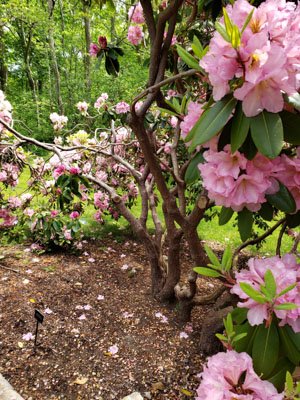*Down to Earth is a weekly garden column in The Sandwich Enterprise written by Heritage’s Director of Horticulture, Les Lutz. For the full article with images please visit The Sandwich Enterprise here.
The recent (never-ending) winds have me thinking about the science of wind and plants. While I don’t claim to be an expert on wind and how it affects plants, I do have a few insights.

Winds affect plants from the time they germinate as seeds and throughout their lives. When plants are seedlings, slight breezes help them grow more sturdily and stronger. But wind at gale force (or above) can significantly damage or blow down the strongest tree, as we’ve seen recently. From a plant health perspective, winter winds can be especially damaging because frozen soils prevent plants from replacing the water they lose and they become desiccated.
Strong winds on the Cape occur mainly in late winter, especially when we experience a northeaster. Temperatures can also fluctuate wildly during the late winter and early spring. Damage to trees can be especially severe when low temperatures are followed by strong wings because the plants are dehydrated and more brittle. Wind-whipped trees and shrubs may suffer broken roots and in many cases actually uproot. If they don’t uproot, the roots can be damaged and the tree left leaning, meaning that you should consider removing it before the next storm.
Smaller plants can be protected using burlap as a windbreak (supported with stakes). This can provide protection from winter cold and wind. You can also place a wire mesh around each plant and fill it loosely with straw or oak leaves. Using an antidessicant spray can be helpful for newly planted trees and shrubs, but make sure it is above 40 degrees Fahrenheit when you apply it.
Plants vulnerable to wind include not only less hardy specimens, but also many hardy plants that are not really adapted to open situations. Slopes can present problems, too. Planting a windbreak (or building a fence) can help to slow the flow of cold air that occurs on even a slight slope, helping to prevent its settling at the lowest point and damaging plants there. Hydrangea macrophylla can be a problem in exposed areas or even in low-lying areas, where cold air settles and causes dieback. An opening in plantings at the bottom of the slope is also helpful to allow cold air to drain out of the garden. A windbreak can cut wind velocity by 75 percent or more and for a distance of up to 10 times the height of the windbreak.
Some plants that do well on the Cape and can be used to break the winds:
- American arborvitae, Thuja occidentalis
- Eastern red cedar, Juniperus virginiana
- European hornbeam, Carpinus betulus Fastigiata
- Atlantic white cedar, Chamaecyparis thyoides
The recent northeasters we’ve had have been a challenge for all in southern New England, especially on the Cape. Storms such as these make clear that we need to do all we can to care for our trees (and shrubs). Proper pruning of damaged or decaying limbs is very important and helps lessen the impact of the winds.






